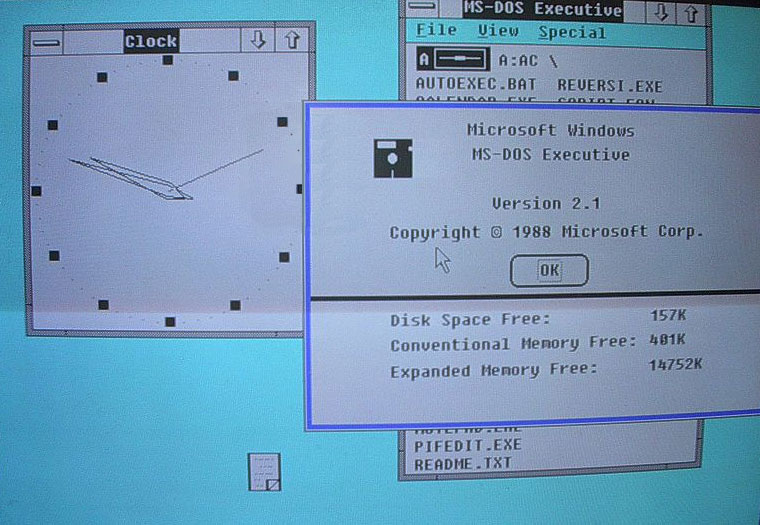- Windows 2.1x
Infobox OS version
name = Windows 2.1x
family = Microsoft Windows

developer =Microsoft
source_model =Closed source
license = Microsoft EULA
kernel_type = N/A
first_release_date = 27 May 1988
first_release_url = http://support.microsoft.com/kb/32905
release_version = 2.11
release_date = 13 March 1989
release_url = http://www.microsoft.com/windows/WinHistoryDesktop.mspx
support_status = Unsupported as of 31 December 2001Windows 2.1x is a family of
Microsoft Windows graphical user interface -basedoperating environment s.Less than a year after the release of
Windows 2.0 , Windows/286 2.10 and Windows/386 2.10 were released on27 May 1988 . These versions can take advantage of the specific features of the Intel 80286 and Intel 80386 processors.Editions
Two editions of Windows 2.10 were released, both of which could take advantage of the Intel processor for which they were designed.
Windows/286
Windows/286 takes advantage of the HMA to increase the memory available to Windows programs. It introduced the himem.sys DOS driver for this purpose. It also includes support for several EMS boards, although this support is not related to the 80286 processor. The segmented nature of Windows programs is quite suited to the usage of EMS, as portions of code and data can be made visible in the first
megabyte of memory accessible to real-mode programs only when the program using them is given control. Microsoft encouraged users to configure their computers with only 256KB of main memory, leaving the address space from 256-640KB available for dynamic mapping of EMS memory.Despite its name, Windows/286 was fully operational on an 8088 or 8086 processor. Windows/286 would simply not use the high memory area since none exist on an 8086-class processor; however, EMS could still be used, if present. A few PC vendors shipped Windows/286 with 8086 hardware; an example was IBM's PS/2 Model 25, which had an option to ship with a "DOS 4.00 and Windows kit" for educational markets, which included word processing and presentation software useful for students, which resulted in some confusion when purchasers of this system received a box labelled Windows/286 with a machine that was definitely less than an 80286.
Windows/386
Windows/386 is much more advanced. It introduced a
protected mode kernel, above which the GUI and applications run as avirtual 8086 mode task. It allows several MS-DOS programs to run in parallel in "virtual 8086" CPU mode, rather than always suspending background applications. (Windows applications could already run in parallel through cooperative multitasking.) Each DOS application can use as much low memory as is available before Windows is started, minus a few kilobytes of overhead. Windows/386 also provides EMS emulation, using the memory management features of the 80386 to make RAM beyond 640K behave like the banked memory previously only supplied by add-in cards and used by popular DOS applications. (By overwriting the WIN200.BIN file withCOMMAND.COM , it is possible to use the EMS emulation in DOS without starting the Windows GUI.) There is no disk-basedvirtual memory , so multiple DOS programs have to fit inside the available physical memory; therefore, Microsoft suggested buying additional memory and cards if necessary.Neither of these versions work with DOS memory managers like
CEMM orQEMM or withDOS extender s, which have their own extended memory management and run in protected mode as well. This was remedied in version 3.0, which is compatible with VCPI in "standard mode" and with DPMI in "386 enhanced" mode. Windows 3.0 also has the capability of using the DWEMM Direct Write Enhanced Memory Module. This is what enables the far faster and sleek graphical user interface.Windows 2.11
In March 1989, Windows 2.11 was released in Windows/286 and Windows/386 editions, with some minor changes in memory management,
AppleTalk support and faster printing and updated printer drivers.Windows 2.11 was superseded by
Windows 3.0 in May 1990.References
* [http://support.microsoft.com/kb/32905 Microsoft Windows Version History]
External links
* [http://video.google.com/videoplay?docid=4915875929930836239 Windows 386 Promotional Video]
Wikimedia Foundation. 2010.
